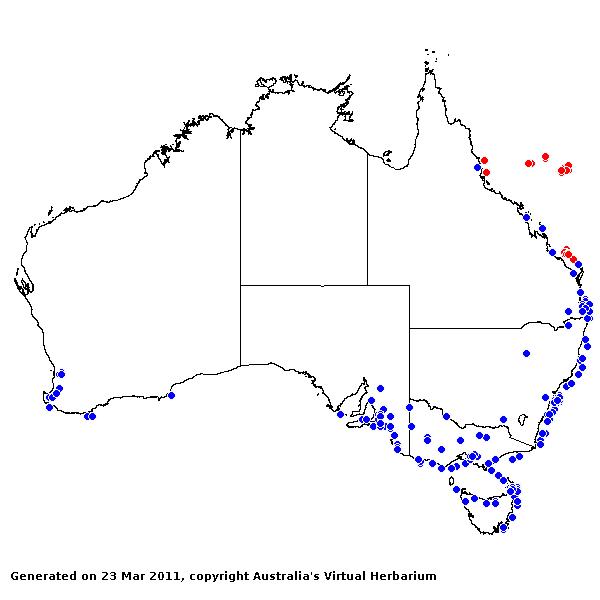Stenotaphrum Fund. Agrost. 175 (1822).
Derivation:. From Greek stenos (narrow) and taphros (trench), alluding to the cavities in the rachis.
Taxonomic revisions, nomenclatural references:. J.D.Sauer, Brittonia 24: 202–222 (1972).
Key references (keys and floras):. G.Bentham, Flora Australiensis 7: 500–501 (1878); C.A.Gardner, Flora of Western Australia 1 Gramineae 242–245 (1952); E.E.Henty, Manual Grasses New Guinea 181 (1969); J.W.Vickery, Flora of New South Wales, Gramineae 19: 264–266 (1975); M.Lazarides, Tropical Grasses S.E. Asia 144–145 (1980); J.C.Tothill and J.B.Hacker, Grasses of Southern Qld 390–391(1983); J.P.Jessop, Flora of South Australia 4: 1979 (1986); B.K.Simon, Key to Australian Grasses 162 (1993); S.W.L.Jacobs and S.M.Hastings, Flora of New South Wales 4: 503 (1993); N.G.Walsh, Flora of Victoria 2: 604–605 (1994); D.I.Morris, Student's Flora of Tasmania 4B: 344–345 (1994); E.Edgar and H.E.Connor, Flora of New Zealand 5: 591–593 (2000); D.Sharp and B.K.Simon, AusGrass (2002); J.P.Jessop, Grasses of South Australia 488–490 (2006); S.W.L.Jacobs, R.D.B.Whalley & D.J.B.Wheeler, Grasses of New South Wales, 4th ed, 380 (2008).
W.D.Clayton & S.A.Renvoize, Genera Graminum (1986), genus (512).
Native and naturalised. 7 species, from tropical and subtropical regions. 2 species in Australia, WA, SA, Qld, NSW, Vic, and Tas. Also New Guinea, Malesia and New Zealand.
Habit. Annual or perennial, rhizomatous or stoloniferous or tufted. Leaf blades broad or narrow. Ligule a fringed membrane.
Inflorescence. Inflorescence of spicate main branches or a false spike, with spikelets on contracted axes (the spikelets 1 to several, in very short spike-like racemes embedded in hollows of the corky or foliaceous common axis, or in longer racemes closely appressed to it), a spike-like panicle, spatheate (the small racemes subtended/enclosed by spathes which are laterally adnate to the rachis) or espatheate, a compound pseudo-inflorescence or not a compound pseudo-inflorescence. Spikelet-bearing axes much reduced (sometimes reduced to one spikelet with no rachis extension, or coalesced with the main axis), falling entire (the free racemes falling with the joint of the main axis) or disarticulating at joints (when the spikelet bearing unit consists of a coalesced main axis and branches).
Spikelets. Spikelets all partially embedded in rachis, dorsally compressed, 2 flowered, with 1 fertile floret, solitary. Fertile spikelets with lower incomplete floret(s), elliptic or lanceolate or ovate, abaxial (with lower glume on side away from rachis), falling with glumes.
Glumes. Glumes unequal, (the longer) long relative to adjacent lemmas or shorter than adjacent lemmas, awnless, dissimilar (lower minute, scale-like, upper large, substantial) or similar (both small, scale-like). Lower glume 0 nerved. Upper glume 5–9 nerved.
Florets. Lower incomplete floret(s) male, or sterile (rarely). Lemmas awnless, 7–9 nerved, similar in texture to fertile lemmas or decidedly firmer than fertile lemmas (leathery or papery), not becoming indurated. Fertile florets 1. Lemmas decidedly firmer than glumes (papery to subleathery), smooth to striate, not becoming indurated, yellow in fruit, entire at apex, pointed, muticous, with a clear germination flap, 3–5 nerved, glabrous, having flat margins not tucked into palea. Palea relatively long, entire (pointed), textured like lemma, 2 nerved. Lodicules 2. Stamens 3. Disseminule comprising rachis segment and associated structures, or consisting of disarticulated spikelet-bearing inflorescence unit, or constituted by complete, deciduous inflorescence. Grain small, ellipsoid, compressed dorsiventrally. Hilum short. Embryo large.
Kranz Anatomy. C4.
2n = 18, 20, and 36, 2 and 4 ploid, commonly adventive.
Habitat. Mesophytic. Usually in sandy soils near the coast, sometimes inland. Species of open habitats.
Classification. Panicoideae; Paniceae.
Notes. Derived from Paspalidium by a progressive reduction of the racemes and expansion of the central axis. Concomitant with retreat of the upper floret into the axis is the transfer of protective induration from the upper lemma to the lower. The swollen inflorescence axis is presumably an adaptation to dispersal by sea, but it only remains buoyant for about a week (Clayton and Renvoize, 1986).
Types Species. S. glabrum Trin. = S. secundatum (Walt.) Kuntze, p.p..
Biogeographic Element. Clifford & Simon 1981, Simon & Jacobs 1990: Gondwanan.


